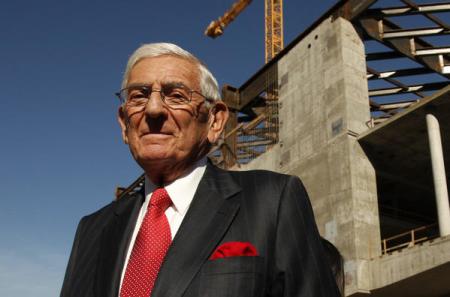Posts Tagged ‘BCAM’
Chapter 2 (Part 3): Venture Philanthropy & Other Styles of Giving
“Andrew Carnegie said, ‘He who dies with wealth dies in shame.’ And someone once said, ‘He who gives while he lives also knows where it goes.’”[i] – Eli Broad
Eli Broad’s power is tolerated because it remains remarkably unchallenged. This seemingly monopoly of philanthropic power led Christopher Knight to compare Broad to another infamous, Los Angeles art patron:
[Norton] Simon’s flirtations with giving [his] collection away (to at least seven institutions); distrust of traditional museum management; engineering of a bailout of an artistically adventuresome but financially faltering institution (the old Pasadena Museum for Simon, MOCA for Broad); later deciding to open his own museum, and more…[ii]
Another similarity to Broad: Before Norton Simon’s takeover of the Pasadena Art Museum, Simon had intended to establish his collection as a lending organization. Taking control of the Pasadena Art Museum proved irresistible to Simon, and today the Norton Simon Museum rarely loans works. I seriously doubt unfounded rumors that Broad has some kind of evil master plan to takeover or somehow combine his collections with MOCA.
Broad can also be measured to his contemporaries. Los Angeles is not actually a one-philanthropist town. “Pomegranate Queen” Lynda Resnick is an easy comparison. Like Broad, Resnick is a long-time donor and trustee of LACMA. Like Broad, she and her husband provided funds ($54 million) for a Renzo-Piano-designed building at LACMA. The Lynda and Stuart Resnick Pavilion was part of Phase 2 of LACMA’s Transformation and sits directly north of BCAM. When the pavilion opened in October of 2010, one of three inaugural shows was gleaned from the Resnick’s private collection.
Chapter 2 (Part 2): The Race for The Broad – A Tale of Three Cities
“I think what Santa Monica has to offer is an incredible audience, a prime location and willingness to work with the Broads.”[i] – Kevin McKeown, Santa Monica City Councilman
Within just a few months of BCAM’s opening at LACMA, rumors began to circulate that Eli Broad had been less than forthcoming about his true intentions. Contrary to his initial denial of it, at the end of 2008 local newspapers began reporting Broad intended to build a new museum for his collections in Beverly Hills.[ii] The City of Beverly Hills quickly identified a prominent parcel of land at the intersections of Wilshire and Santa Monica Boulevards for the project. An architectural competition was announced, a short list determined (Thom Mayne, Jean Nouvel, Shigeru Ban, Rafael Viñoly and Christian Portzamparc), and schematic renderings of the site plan were even published. [iii] If this speedy development seemed too good to be true, it’s because it was.
By the end of 2009, Broad announced that there were actually multiple cities vying for his collections and a new museum building to house them. Beverly Hills, previously unchallenged was suddenly competing with the City of Santa Monica, and Broad’s foundation announced there was also a third, unnamed city in the running.[iv] This of course turned out to be the City of Los Angeles. Broad said he wasn’t, “trying to play the two [three] municipalities against each other […] he hope[d] that by talking to several different cities he c[ould] accelerate the process of building.”[v] But play them against each other he did, for six months, trying to secure the best deal.
Chapter 1 (Part 1): One Eli Broad Too Many, Or Not Enough?
“Eli is not the problem. The problem is that we don’t have enough Elis in Los Angeles to balance out his generosity and the power of his influence.”[i] – Ann Philbin, Director, Hammer Museum
Photographs of Los Angeles from fifty years ago capture an unfamiliar city. In the 1960s, downtown’s Bunker Hill was still occupied by a row of quiet Victorian houses. Since then, the Victorians have been cleared away and the city has experienced a population boom often illustrated as a mushroom cloud-shaped diagram, and now boasts a population of 9.86 million.[ii] While established in many ways, Los Angeles’s philanthropic culture is still in its infancy. Despite ranking the second most populous city in America, the quantity of powerful philanthropists is insignificant at best. Those who are active give to educational, environmental, health, and political causes.




